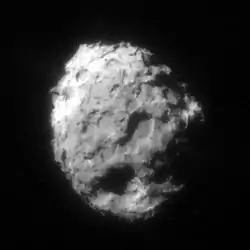Comet of 1729
The Comet of 1729, also known as C/1729 P1 or Comet Sarabat, was an assumed parabolic comet with an absolute magnitude of −3,[3][4] the brightest ever observed for a comet;[5] it is therefore considered to be potentially the largest comet ever seen.[6] With an assumed eccentricity of 1,[1] it is unknown if this comet will return in a hundred thousand years or be ejected from the Solar System.
| Discovery | |
|---|---|
| Discovered by | Fr. Nicolas Sarabat |
| Discovery date | August 1, 1729 |
| Alternative designations | C/1729 P1, 1729, Comet of 1729 |
| Orbital characteristics A | |
| Epoch | 2352731.148 (June 16, 1729) |
| Observation arc | 135 days |
| Number of observations | 3 (very poorly determined) |
| Perihelion | 4.05054 AU[1] |
| Eccentricity | 1.0 (assumed)[1] |
| Inclination | 77.095°[1] |
| Dimensions | ≈100 km?[2] |
| Last perihelion | June 16, 1729[1] |
| Next perihelion | Ejection trajectory assumed |
Discovery
The comet was discovered in the constellation of Equuleus by Father Nicolas Sarabat, a professor of mathematics, at Nîmes in the early morning of August 1, 1729.[7] At the time of discovery the comet was making its closest approach to Earth of 3.1 AU (460,000,000 km; 290,000,000 mi) and had a solar elongation of 155 degrees.[8]
Observing with the naked eye, he saw an object resembling a faint, nebulous star: he was at first unsure if it was a comet or part of the Milky Way. Moonlight interfered with Sarabat's observations until August 9, but after recovering the object and attempting to detect its motion without the aid of any measuring instruments, he became convinced that he had found a new comet.[8]
News of the discovery was passed to Jacques Cassini in Paris. He was able to confirm the comet's position, though with extreme surprise at how little it had moved since the first observation nearly a month previously. Cassini was able to continue observation until 18 January 1730, by which time the comet was located in Vulpecula. This was an extraordinarily long period for observation of a comet, though it never rose above apparent magnitude 3–4, about the brightness of the Andromeda Galaxy.
Orbit
The comet's orbit, later computed by John Russell Hind, showed a perihelion distance (closest approach to the Sun) of 4.05 AU[1] which is just within the orbit of Jupiter. However, despite this it became visible, although faintly, to the naked eye, and indeed remained visible for six months in total. This suggests that its absolute magnitude or intrinsic brightness was unusually high, possibly as high as −3.0.[3][4] It is therefore likely that the Comet of 1729 was an exceptionally large object, with a cometary nucleus of the order of 100 km in diameter.[2] The JPL small-body database only uses three observations, a two-body model, and an assumed epoch to compute the orbit of this parabolic comet.[1] With such a limited dataset, undefined uncertainties, and an assumed eccentricity of 1,[1] it is unknown if the comet will return on the order of 100000 years or be ejected from the Solar System.
References
- "JPL Small-Body Database Browser: C/1729 P1". Jet Propulsion Laboratory. Retrieved 2011-07-26. last observation: 1730-01-16 (only 3 observations using a two-body model; very poorly determined)
- Sagan, Carl and Druyan, Ann Comet, Ballantine, 1997 pg137
- Kidger, M. 'Comet Hale-Bopp Light Curve', NASA JPL, accessed 24-Nov-2008
- Light Curve Behaviour in C/1995 O1 (HALE-BOPP) - II; Changes in the activity between 13AU and 2.5AU pre-perihelion pg 90
- Comet Caesar (C/-43 K1) has, however, been calculated to have possibly had the brightest absolute magnitude in recorded history: −3.3 at the time of discovery and −4.0 during a later flare-up; cp. John T. Ramsey & A. Lewis Licht, The Comet of 44 B.C. and Caesar's Funeral Games, Atlanta, 1997, ISBN 0-7885-0273-5.
- Moore, P. The Data Book of Astronomy, CRC, 2000, p.232
- Lynn, W.T. (1896). "Sarrabat and the comet of 1729". The Observatory. 19: 239–240. Bibcode:1896Obs....19..239L.
- Kronk, G. W. Cometography: A Catalog of Comets, Cambridge University Press, 1999, pg 394

